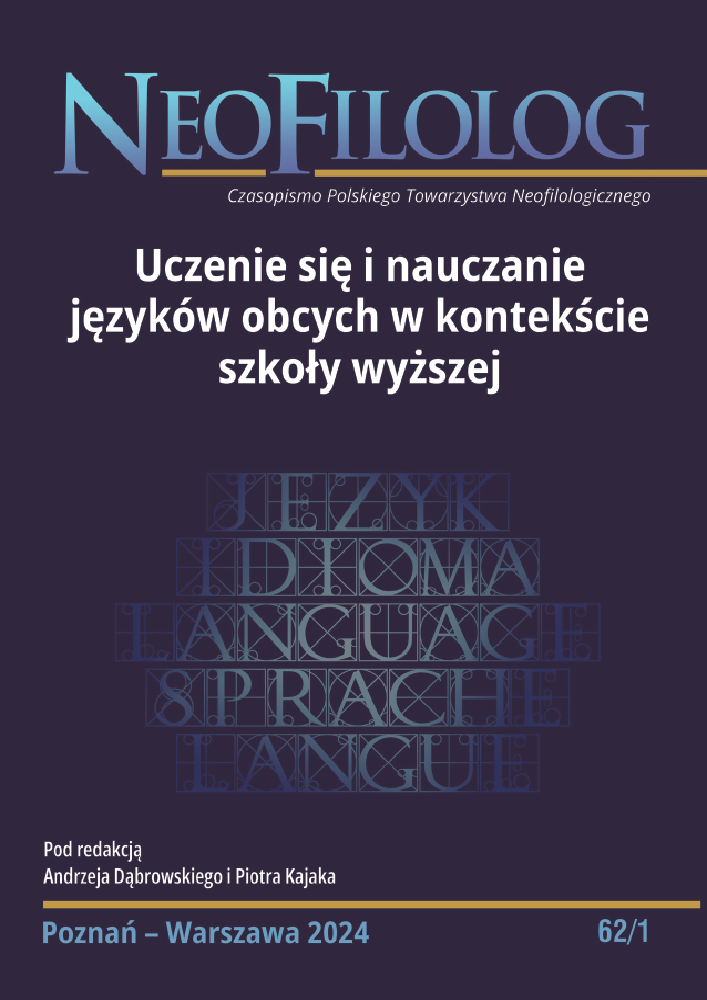Abstrakt
The aim of the article is to present good practices and effective solutions adopted in the plurilingual and multicultural education, integrated language didactics and virtual exchange courses at the Centre for Foreign Language Teacher Training and European Education of the University of Warsaw. During classes students become familiar with pluralistic approaches to languages and cultures, language didactics for tertiary education, and different aspects of intercultural communication. The classes help the students to develop plurilingual and intercultural competence, including the skill of linguistic and intercultural mediation. The students also learn how to plan and organize project work and how to promote linguistic and cultural diversity during a foreign language lesson at school. The article discusses methods and tools used during these classes and gives examples of tasks carried out by the students. These are, among others, an intercultural project, which consists in carrying out and recording interviews with foreigners living in Poland and integrated didactic tasks, during which students learn to notice and analyse relations between languages. The integrated didactic tasks concentrate on relations between the students’ mother tongue, the first foreign language (English) and additional languages which, in the case of the students of the Centre and their future learners, are German and French. The article also shows the way in which a tool for comparing national cultures (available at hofstede-insights.com), related to Hofstede’s cultural dimensions, can be used. The examples of tools and tasks presented in the article are intended to show how to effectively promote cultural and linguistic diversity and how to help the students, who are future teachers of foreign languages develop plurilingual and intercultural competences.
Bibliografia
Baldwin J. R. i in. (2014), Intercultural Communication for Everyday Life. Chichester: Wiley- Blackwell.
Barrett M. i in. (2014), Developing intercultural competence through education. Pestalozzi Series No. 3, Strasbourg: Council of Europe Publishing, Strasbourg.
Candelier M. i in. (2017), FREPA. System opisu pluralistycznych podejść do języków i kultur. Kompetencje i zasoby. Warszawa: Ośrodek Rozwoju Edukacji.
Candelier M. (2016), Activités métalinguistiques Pour une didactique intégrée des langues (w:) Le français aujourd’hui 192, s. 107–116. Online: https://www.cairn.info/revue-le-francais-aujourd-hui-2016-1-page-107.htm?contenu=article [DW 28.09.2023] DOI: https://doi.org/10.3917/lfa.192.0107
Coste D., Moore D., & Zarate G. (2009), Plurilingual and Pluricultural Competence. Strasbourg: Council of Europe. (Original work 1997).
Council of Europe (2020), Common European framework of reference for languages: Learning, teaching, assessment – Companion volume. Strasbourg: Council of Europe.
Council of Europe (2022), The importance of plurilingual and intercultural education for democratic culture: Recommendation CM/Rec(2022)1 and explanatory memorandum. Strasbourg: Council of Europe.
Hofstede G., Hofstede G. J., Minkov M. (2010), Cultures and organizations – Software of the mind: Intercultural cooperation and its importance for survival. New York: McGraw Hill.
Hofstede G., Hofstede G.J., Minkov M. (2011), Kultury i organizacje. Zaprogramowanie umysłu. Warszawa: Polskie Wydawnictwo Ekonomiczne.
Hofstede G. & Hofstede G. J. (b. d.), 6d model of national culture. Online: https://geerthofstede.com/culture-geert-hofstede-gert-jan-hofstede/6d-model-of-national-culture/ [DW 28.09.2023]
Kucharczyk R. (2018), Nauczanie języków obcych a dydaktyka wielojęzyczności (na przykładzie francuskiego jako drugiego języka obcego). Lublin: Werset.
Neuner G. (2004), The concept of plurilingualism and tertiary language didactics, (w:) Hufeisen B., Neuner G. (red.), The Plurilingualism Project: Tertiary Language Learning – German after English. Strasbourg: Council of Europe, s. 13–34.
Zarzycka G. (2008), Opis pedagogiki zorientowanej na rozwój kompetencji i wrażliwości interkulturowej, (w:) Miodunka W. T., Seretny A. (red.), W poszukiwaniu nowych rozwiązań. Dydaktyka języka polskiego jako obcego u progu XXI wieku. Kraków: Wydawnictwo UJ, s. 63–78.
https://culture.pl/pl [DW 20.05.2023]
https://geerthofstede.com/ [DW 27.09.2023]
https://hofstede-insights.com/ [DW 27.09.2023]
Licencja
Prawa autorskie (c) 2024 Elżbieta Sielanko-Byford, Janina Zielińska

Utwór dostępny jest na licencji Creative Commons Uznanie autorstwa – Bez utworów zależnych 4.0 Międzynarodowe.
Przedstawiany utwór (artykuł) upubliczniany jest na podstawie umowy z autorem i na licencji Creative Commons Attribution-NoDerivatives 4.0 International (CC BY-ND 4.0).
Użytkownicy mają obowiązek podania wraz z rozpowszechnionym utworem, informacji o autorstwie, tytule, źródle (odnośniki do oryginalnego utworu, DOI) oraz samej licencji;
- bez tworzenia utworów zależnych,
- utwór musi być zachowany w oryginalnej postaci.
Uniwersytet im. Adama Mickiewicza w Poznaniu zachowuje prawo do czasopisma jako całości (układ, forma graficzna, tytuł, projekt okładki, logo itp.).

